|

Part 1 of 4 articles
The Art of Arabic Calligraphy
The Language and The Script
© Mamoun Sakkal 1993
Arabic belongs to the group of Semitic alphabetical scripts in which mainly the consonants are represented in writing,
while the markings of vowels (using diacritics) is optional. The earliest-known alphabet to mankind was the North Semitic,
which developed around 1700 B.C. in Palestine and Syria. It consisted of 22 consonant letters. The Arabic, Hebrew, and Phoenician
alphabets were based on this model. Then, around 1000 B.C., the Phoenician alphabet was itself used as a model by the Greeks,
who added letters for vowels. Greek in turn became the model for Etruscan (c. 800 B.C.), whence came the letters of the ancient
Roman alphabet, and ultimately all Western alphabets.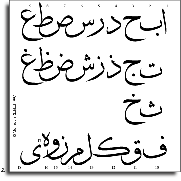
The North Arabic script, which eventually prevailed and became the Arabic script of the Quran, relates most substantially
and directly to the Nabatian script, which was derived from the Aramaic script. Old Aramaic, the language of Jesus and the
Apostles, dates from the 2nd millennium B.C., and some dialects of which are still spoken by tiny groups in the Middle East.
Arabic script still shares with Aramaic the names of the alphabet letters (Alef, Jeem, Dal, Zai, Sheen, etc.); similar
graphic representation for phonetically similar letters (Sad and Dad, Ta and Tha, etc.); connections of letters in the same
word and several forms of each letter depending on its location in the word, except for letters that cannot be connected to
the letters which come after them (Alef, Dal/Dthal, Raa/Zai, Waw). The Arabic alphabet contains 18 letter shapes, by adding
one, two, or three dots to letters with similar phonetic characteristics a total of 28 letters is obtained. These contain
three long vowels, while diacritics can be added to indicate short vowels. 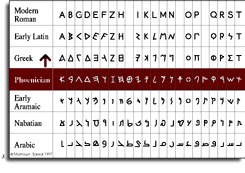
With the spread of Islam, the Arabic alphabet was adapted by several non-Arab nations for writing their own languages.
In Iran Arabic letters were used to write Farsi, with the addition of four letters to represent the phonetics that did not
exist in Arabic: p, ch, zh, and g. The Ottoman Turks used the Arabic alphabet until 1929 and added still another letter. This
alphabet was also used to write other Turkish languages and dialects, such as Kazakh, Uzbek, etc. Several other languages
used the Arabic alphabet at one time or another, including Urdu, Malay, Swahili, Hausa, Algerian Tribal, and others.
From its simple and primitive early examples of the 5th and 6th century A.D., the Arabic alphabet developed rapidly after
the rise of Islam in the 7th century into a beautiful form of art. The main two families of calligraphic styles were the dry
styles, called generally the Kufic, and the soft cursive styles, which include Naskhi, Thuluth, Nastaliq and many others.
Article and figures © copyright 1993 by Mamoun Sakkal
Part 2 of 4 articles
The Art of Arabic Calligraphy
A Brief History
© Mamoun Sakkal 1993
Islam in Arabic means "submission" and derives from a word meaning "peace," for it is in submitting to God's Will that
human beings gain peace in their lives in this world and the hereafter. Islam is a universal message revealed in the sacred
book, the Quran, through the Prophet Muhammad, and shares with the other Abrahamic religions, Judaism and Christianity, their
ethical teachings and the belief in the One God. Islam is both a religion and a way of life.
For Muslims the Quran is the actual Word of God revealed through the archangel Gabrielle to the Prophet of Islam during
the twenty-three year period of his prophetic mission. It was revealed in the Arabic language, which became therefore the
language of Islam even for non-Arab Muslims.
Early calligraphic developments
The North Arabic script, which was influenced by the Nabatian script,
was established in north-eastern Arabia and flourished in the 5 th century among the Arabian tribes who inhabited Hirah and
Anbar. It spread to Hijaz in western Arabia, and its use was popularized among the aristocracy of Quraysh, the tribe of the
Prophet Muhammad, by Harb ibn Ummayyah.
Although early Arabic sources mention several calligraphic styles in reference to the cities in which they were used, they
generally fit into two broad categories with some minor variations, these are the "dry styles," the early predecessors of
Kufic, and the "moist styles," the early predecessors of the cursive family or scripts.
The reform of Arabic script
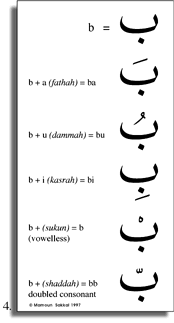 With the increasing number of non-Arab Muslims, there was a greater need for facilitating reading and learning of Arabic.
Since several letters of the Arabic alphabet share the same shapes, and since vowels are not clearly indicated, some reform
was needed to avoid confusion, and a system of Naqt or I'jam (letter-pointing), and Tashkeel (vowel indication) was developed. With the increasing number of non-Arab Muslims, there was a greater need for facilitating reading and learning of Arabic.
Since several letters of the Arabic alphabet share the same shapes, and since vowels are not clearly indicated, some reform
was needed to avoid confusion, and a system of Naqt or I'jam (letter-pointing), and Tashkeel (vowel indication) was developed.
Abul Aswad al Du'ali (d. 688) was the legendary founder of Arabic grammar, and is credited with inventing the system of
placing large colored dots to indicate the Tashkeel. It was used with the Kufic scripts, but proved to be somewhat cumbersome
to use with smaller scripts, or in ordinary writing.
The Ummayad governor al Hajjaj ibn Yusuf al Thaqafi enforced a uniform system to distinguish letters by using dots, which
he asked two of al Du'ali's students to codify.
Al Khalil ibn Ahmad al Farahidi (d. 786) devised a tashkeel system to replace
Abu al Aswad's. His system was universally used since the early eleventh century, and included six diacritical marks:
Fathah
(a), Dammah (u), Kasrah (i), Sukun (vowelless), Shaddah (double consonant), and Maddah (vowel prolongation) which is applied
to the Alef.
Development of cursive scripts
Cursive scripts coexisted with Kufic and date back to before Islam,
but because in the early stages of their development they lacked discipline and elegance, they were usually used for secular
purposes only.
Under the Ummayads and Abbasids, court requirements for correspondence and record keeping resulted in many developments
to the cursive scripts, and several styles were devised to fulfill these needs. Abu Ali Muhammad Ibn Muqlah (d. 940), along
with his brother, became accomplished calligraphers in Baghdad in an early age. Abu Ali became a Vizir to three Abbasid caliphs,
and is credited with developing the first script to obey strict proportional rules. His system utilized the dot as a measuring
unit for line proportions, and a circle with a diameter equals to the Alef's height as a measuring unit for letter proportions.
Ibn Muqlah's system became a powerful tool in the development and standardization of cursive scripts, and his calligraphic
work elevated the previous cursive styles into a place of prominence, and made them acceptable as worthy of writing the Quran.
Article and figures © copyright 1993 by Mamoun Sakkal
Part 3 of 4 articles
The Art of Arabic Calligraphy
The Kufic Styles
© Mamoun Sakkal 1993
The city of Kufah was established in Iraq in the year 641 A.D. It flourished in a short time from a soldiers' camp into
an urban center with vital cultural activities. Among these activities was the refinement of the Arabic script into an elegant
and rather uniform script, which came to be known as Kufic or Kufi. It had a combination of square and angular lines on one
hand, and compact bold circular forms on the other hand. The vertical strokes were short, while the horizontal strokes were
long and extended. As Kufic reached perfection in the second half of the 8 th century, it superseded other earlier attempts
of improvement of Arabic calligraphy, and became the only script used for copying the Holy Quran for the next three hundred
years.
When the cursive styles were becoming popular and refined in the 10 th century, Kufic responded by overemphasizing
many qualities of the cursive scripts in a geometrical style called 'Eastern Kufic,' where slender vertical strokes and oblique
strokes animate the more rigid early Kufic. This style was mainly a book calligraphy rather than architectural calligraphy
style, but was very popular on ceramics.
On architectural monuments, serifs were added to simple early Kufic since
the 8 th century, and leaf-like vegetal ornaments appear as early as 866 at the ends of vertical strokes. These ornaments
were later added to round strokes, and the Foliate Kufic became the most popular style for architectural inscriptions since
the 10 th century.
In the 11 th century the letters themselves started to be modified and used as ornaments, and new
geometric elements started to appear in the form of plaiting, knotting, and braiding2. The exaggerated use of such ornaments
created complex compositions, which were difficult to decipher at times.
During the 13 th and 14 th centuries, Square
Kufic developed out of the use of calligraphy in buildings. Its simple forms contrast with the trend to develop more complex
calligraphic compositions. It was the only calligraphic style used to cover entire buildings, a practice unique to Islamic
architecture.
Article and figures © copyright 1993 by Mamoun Sakkal
Part 4 of 4 articles
The Art of Arabic Calligraphy
© Mamoun Sakkal 1993
The cursive script dates back at least to the first decades of the Muslim era. The early examples, however, lacked elegance
and discipline and were used mainly for secular and practical, rather than aesthetic, purposes. In a slow but continuous process,
older styles were perfected, while new styles were invented to meet the demands of different occasions. 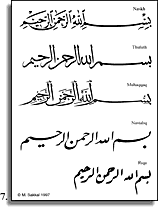
Naskh, which means "copying," was developed in the 10th century, and refined into a fine art form in Turkey in the 16th
century. Since then it became generally accepted for writing the Quran. Naskh is legible and clear and was adapted as the
preferred style for typesetting and printing. It is a small script whose lines are thin and letter shapes are round.
Thuluth
is a more impressive, stately calligraphic style which was often used for titles or epigrams rather than lengthy texts. Its
forms evolved over the centuries, and many variations are found on architectural monuments, as well as on glass, metalwork,
textiles, and wood. Mamluk Thuluth of the 14th century was heavy and large, while the Ottomans preferred the simpler more
refined version still practiced today.
The traditional classification of the main styles includes in addition to the
above Muhaqqaq which is less round than Thuluth; Rayhani which is similar to a small Muhaqqaq; Tawqi which has many ligatures,
and a miniature version of it called Riqa' used mostly for personal and informal occasions. All these styles are now obsolete
and rarely used.
Nastaliq developed in Iran in the 14 th and 15 th centuries. It is the most fluid and expressive
of the scripts presented here, and is used extensively in copying romantic and mystical epics in Persian. Nastaliq has very
short verticals without any "serifs," and deep curved horizontals. It slants to the right in contrast to all the other styles
which slant to the left.
Riq'a, the simpler style of everyday writing is very economical and easy to write. It replaces
the above mentioned Riqa', and is popular for writing both Turkish and Arabic.
There are still many other styles used
in different places and times that can't be all mentioned in this limited space, but they combine to form a fantastic wealth
of artistic creativity and ever renewing vigor.
Article and figures © copyright 1993 by Mamoun Sakkal
These articles were prepared for Seattle Art Museum's Educational Resource Room, and can be adapted to accompany Arabic and Islamic calligraphy exhibitions at other museums
as well.
Figures:
1. The Arabic Alphabet has 28 letters. The shape of these letters changes depending on their position in the word, whether isolated; in the beginning
of the word (initial); in the middle (medial); or at the end (final).
2. Several letters in the Arabic alphabet share the same shape, and are differentiated only by the number and placement of dots on the letters. Of the basic 18 shapes, 2 are used for three
letters, 6 are used for two letters, and the remaining 10 are used for one letter each.
3. The Arabic and Phoenician alphabets, along with several other alphabets such as Hebrew and Aramaic, are based on an early model called the North Semitic. The
Phoenician alphabet was adapted by the Greeks, then the Etruscans and Romans, and eventually became the Western alphabet as
we know it today.
4. Al Khalil ibn Ahmad al Farahidi devised a tashkeel system to replace Abu al Aswad's. His system was universally used since the early eleventh century, and included six diacritical
marks to indicate the small vowels attached to Arabic letters.
5. The measuring system of Ibn Muqlah is based on a circle with a diameter that equals the height of the letter Alef. It controls the correct proportions
of the letters by comparing them to the circle, and by diagonal dots written with the calligraphy pen.
6. Samples of Kufi Styles of Arabic calligraphy. From top to bottom: Early Kufi, Eastern Kufi, Foliate Kufi, Knotted Kufi, and Square Kufi.
7. Samples of Cursive Styles of Arabic calligraphy. From top to bottom: Naskh, Thuluth, Muhaqqaq, Nastaliq, and riq'a.


ART OF ARABIC CALLIGRAPHY

1. The Arabic Alphabet has 28 letters. The shape of these letters changes depending on their position in the
word, whether isolated; in the beginning of the word (initial); in the middle (medial); or at the end (final).

ART OF ARABIC CALLIGRAPHY
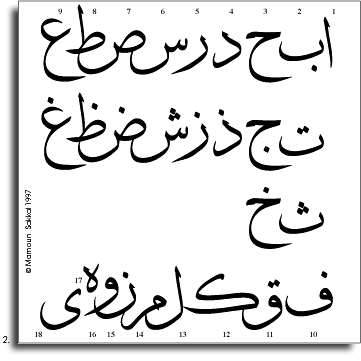
2. Several letters in the Arabic alphabet share the same shape, and are differentiated only by the number
and placement of dots on the letters.
Of the basic 18 shapes, 2 are used for three letters, 6 are used for two letters,
and the remaining 10 are used for one letter each.

2.1. In addition to the basic letter forms in figure 2, there are two additional forms of letters that are
needed when writing Arabic:
The first is called the Hamza (19). It is a different representation of the letter Alif (1).
The
second is called Lamalif (20). It is a required ligature that combines the letters Lam (13) and Alif (1).

ART OF ARABIC CALLIGRAPHY
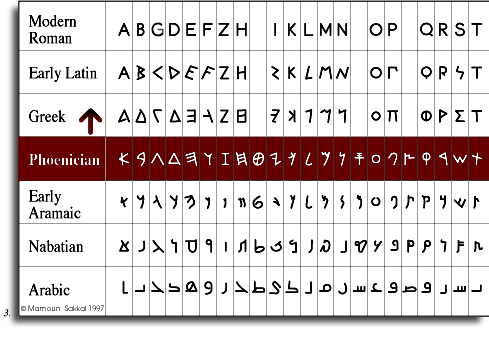
3. The Arabic and Phoenician alphabets, along with several other alphabets such as Hebrew and Aramaic, are
based on an early model called the North Semitic. The Phoenician alphabet was adapted by the Greeks, then the Etruscans and
Romans, and eventually became the Western alphabet as we know it today.

ART OF ARABIC CALLIGRAPHY

4. Al Khalil ibn Ahmad al Farahidi devised a tashkeel system to replace Abu al Aswad's. His system was universally
used since the early eleventh century, and included six diacritical marks to indicate the small vowels attached to Arabic
letters.

ART OF ARABIC CALLIGRAPHY
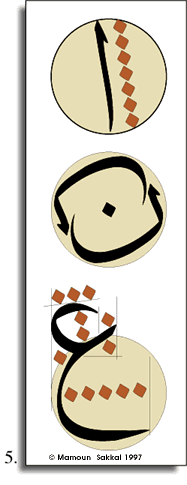
5. The measuring system of Ibn Muqlah is based on a circle with a diameter that equals the height of the letter
Alef. It controls the correct proportions of the letters by comparing them to the circle, and by diagonal dots written with
the calligraphy pen.
Back to Art of Arabic Calligraphy

ART OF ARABIC CALLIGRAPHY
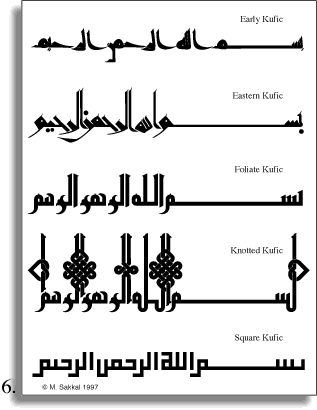
6. Samples of Kufi Styles of Arabic calligraphy. From top to bottom:
Early Kufi, Eastern Kufi, Foliate
Kufi, Knotted Kufi, and Square Kufi.

ART OF ARABIC CALLIGRAPHY
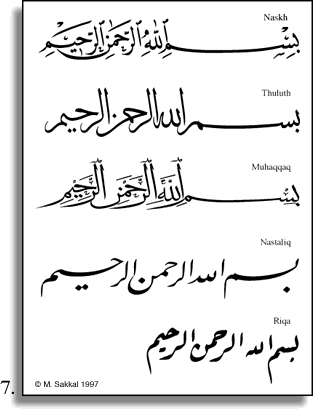
7. Samples of Cursive Styles of Arabic calligraphy. From top to bottom:
Naskh, Thuluth, Muhaqqaq, Nastaliq,
and riq'a.
6. Writing Arabic, part I

Click on Arabic letters to play sound. Click here to get necessary software.


|

Explanation

The little secret to understand writing Arabic, is thinking of it as handwriting.
Just like you connect letters together when you write, so you will connect letters when you write Arabic. Their shapes will
change in order to adjust to the writing of other letters, so that it becomes possible to write without lifting the
pen up from the paper (of course, when marking the dots, you will have to).
 22 of the 28 Arabic letters have 4 variants: 22 of the 28 Arabic letters have 4 variants:
1. Standing alone.
2. As the first letter in a word.
3. Inside the word, between two other letters.
4.
As the last letter in a word, joining to the letter in front. As for the remaining 6, they never join to the following
letter, even when they are inside a word. This means that the writer has to lift his pencil, and even if he is inside the
same word, the following letter will have to be written as if it was the first in a word. Examples of these odd 6, see 'alif
and w?. |

|  'a/'u/i/?/B> ('alif) 'a/'u/i/?/B> ('alif)

b (b?)

t (t?)

th (th?)

m (m?)

w/?/B> (w?)

h (h?)

y/?/B> (y?)
Examples and Grammar

 yawm- (one) day. This word is made out of three letters, y?, w? and m?. But
as you see in the Latin translitteration, there is a forth letter coming through: 'a'. This is the short a, unlike the long
a, as in 'alif above. In Arabic this is the source of frustration for beginners: Short vowels are not written. That is, there
is a way of writing the three short vowels, is small curls above or under the letter it follows, but beyond sometimes religious
works, and school books, these are omitted. yawm- (one) day. This word is made out of three letters, y?, w? and m?. But
as you see in the Latin translitteration, there is a forth letter coming through: 'a'. This is the short a, unlike the long
a, as in 'alif above. In Arabic this is the source of frustration for beginners: Short vowels are not written. That is, there
is a way of writing the three short vowels, is small curls above or under the letter it follows, but beyond sometimes religious
works, and school books, these are omitted.
 The 3 short vowels are: a, u, i. And that's it! The 3 short vowels are: a, u, i. And that's it!
 There is a system to how these vowels are used,- Arabic is a very organised language. For now, just settle with learning the
sound of each word. That is the best. There is a system to how these vowels are used,- Arabic is a very organised language. For now, just settle with learning the
sound of each word. That is the best.
 'umm?/B>- my mother. With this word, you should note
the following: The double letters of m?, are not written each by themselves, they are written as one letter. There is a curl
to indicate just this, but at this beginner's level, the same rule applies as for the short vowels: Learn the sound for each
word. 'umm?/B>- my mother. With this word, you should note
the following: The double letters of m?, are not written each by themselves, they are written as one letter. There is a curl
to indicate just this, but at this beginner's level, the same rule applies as for the short vowels: Learn the sound for each
word.
 Note that the suffix of a y?, is the straightforward way of indicating "mine", "my", or "of "me". When putting y? at the very
end of a word, pronouncing and writing it as one word, you can't go wrong. Note that the suffix of a y?, is the straightforward way of indicating "mine", "my", or "of "me". When putting y? at the very
end of a word, pronouncing and writing it as one word, you can't go wrong.
 wathaba- to jump, to leap This is a verb. Note that it really means "he jumped,
he leaped", as masculin singular past, is presented as the core form for a verb. wathaba- to jump, to leap This is a verb. Note that it really means "he jumped,
he leaped", as masculin singular past, is presented as the core form for a verb.
 Arabic verbs are declined stricly according to 1., 2., or 3. person, gender, and singular, dualis (!!!) and plural. But the
good news is: Only two tenses: Perfect (past) and Imperfect (now), while Futurum is simply made by adding the prefix "sa-"
to the Imperfect form. Arabic verbs are declined stricly according to 1., 2., or 3. person, gender, and singular, dualis (!!!) and plural. But the
good news is: Only two tenses: Perfect (past) and Imperfect (now), while Futurum is simply made by adding the prefix "sa-"
to the Imperfect form.
 t?a- to repent. Surprise, surprise! One letter becomes another one!! t?a- to repent. Surprise, surprise! One letter becomes another one!!
 One of the more time consuming challenges students of Arabic will have to face, is getting a hold on the many irregularities
that occur when one of these 3 letters are found in a verb: One of the more time consuming challenges students of Arabic will have to face, is getting a hold on the many irregularities
that occur when one of these 3 letters are found in a verb:
'alif, w? and/or y?
Sometimes they are transformed into one of the others, sometimes they disappear.
 But for now: Forget all about it. And save your strength until we get there. But for now: Forget all about it. And save your strength until we get there.
 wahaba- to give. Puh! This time, nothing special happened to the w?, but when
declining this verb, unpleasant things will become evident. wahaba- to give. Puh! This time, nothing special happened to the w?, but when
declining this verb, unpleasant things will become evident.
7. Writing Arabic, part II

Click on Arabic letters to play sound. Click here to get necessary software.


|

Explanation

As it would become more and more apparent, most Arabic letters have the
same shape as one, two or three others, but that dots are used to separate them. Dots in our days, can never be omitted.
 This lesson introduces altogether 4 sounds that are unfamiliar to most Western languages. These have one common factor, they
are heavily stressed. Special attention should be paid to the cayn, as well as to the ghayn. The former is a new
sound to most, and calls for special practice,- few Arabic students do this, unfortunately they leave it as a pausal stop. This lesson introduces altogether 4 sounds that are unfamiliar to most Western languages. These have one common factor, they
are heavily stressed. Special attention should be paid to the cayn, as well as to the ghayn. The former is a new
sound to most, and calls for special practice,- few Arabic students do this, unfortunately they leave it as a pausal stop.
 Ghayn is not difficult to pronounce when standing alone, but can easily disappear when inside a word. Ghayn is not difficult to pronounce when standing alone, but can easily disappear when inside a word.
 The t? marb?a belongs to a category of itself: It is more a femine mark, than a letter. In most cases it should not be pronounced,
but f.x. when suffixes follow, it is pronounced as a normal t (it is a mixture of the letters h? and t?). The t? marb?a belongs to a category of itself: It is more a femine mark, than a letter. In most cases it should not be pronounced,
but f.x. when suffixes follow, it is pronounced as a normal t (it is a mixture of the letters h? and t?). |

| 
j (j?)

h (hā') stressed h- always transliterated in bold

kh (khā')

c (cayn)

gh (ghayn)

[-at] (tā' marbūta)

l (lām)
Examples and Grammar

 khalaca- to undress. khalaca- to undress.
 jacala- become; bring [someone into a state]. Arabic is a very rich language in its vocabulary. This
means that expressions can be very clear, or consciously vague. For the student of Arabic, this is a challenge. jacala- become; bring [someone into a state]. Arabic is a very rich language in its vocabulary. This
means that expressions can be very clear, or consciously vague. For the student of Arabic, this is a challenge.
 This verb is only one out of many different verbs that carry more or less the same meaning. But do not be scared: Most of
the different words are true synonyms in normal use of Arabic. This verb is only one out of many different verbs that carry more or less the same meaning. But do not be scared: Most of
the different words are true synonyms in normal use of Arabic.
 ghalla- crops, produce, yield. Here again, note that double consonants always are written with one letter only.
This noun has the feminine mark, which is only pronounced (as a t), if there is a suffix following it. ghalla- crops, produce, yield. Here again, note that double consonants always are written with one letter only.
This noun has the feminine mark, which is only pronounced (as a t), if there is a suffix following it.
 Very often, when it has nothing to do with human beings, the same noun can indicate two quite different things,- with only
the feminine mark as a difference. Very often, when it has nothing to do with human beings, the same noun can indicate two quite different things,- with only
the feminine mark as a difference.
 Hajj- greater pilgrimage. This is the word for the most central religios act in Islam,- the pilgrimage to Mecca. Hajj- greater pilgrimage. This is the word for the most central religios act in Islam,- the pilgrimage to Mecca.
 H?- state, situation. Sorry! Here it was again, one letter that is substituted with another. But as you see
it was a w? that turned into 'alif, that is one of the long vowels. Normal consonants will only have this thing happening
to them, in a very limited number of cases (and you won't need to worry much about that for still a long time). H?- state, situation. Sorry! Here it was again, one letter that is substituted with another. But as you see
it was a w? that turned into 'alif, that is one of the long vowels. Normal consonants will only have this thing happening
to them, in a very limited number of cases (and you won't need to worry much about that for still a long time).
|
8. Writing Arabic, part III

Click on Arabic letters to play sound. Click here to get necessary software.


|

Explanation

Here comes the largest chunk of Arabic letters that only can be written
in two variants: Standing alone, following another letter. None of these allows any subsequent letter to join. This involves
that the writer will have to lift his pencil up from the paper, and write that subsequent letter as if it was the first in
a word.
 The last letter, the hamza, is not really a letter, there is no sound to it, and in transcriptions, no Latin letter is used,
only an apostrophe. What the hamza indicates is a pausal stop in the pronounciation. No sound, simply a little stop. However,
the hamza is no big obstacle for the Arabic student. Few Arabs emphasize the hamza when they speak themselves. The last letter, the hamza, is not really a letter, there is no sound to it, and in transcriptions, no Latin letter is used,
only an apostrophe. What the hamza indicates is a pausal stop in the pronounciation. No sound, simply a little stop. However,
the hamza is no big obstacle for the Arabic student. Few Arabs emphasize the hamza when they speak themselves. |

| 
d (d?)

dh (dh?)

r (r?)

z (z?)

f (f?)

q (q?)

k (k?)

' (hamza)
Examples and Grammar

 qadhafa- to shoot; throw; ejaculate. Here you see in practice what letters that only can be written in one out
of two forms, behave. qadhafa- to shoot; throw; ejaculate. Here you see in practice what letters that only can be written in one out
of two forms, behave.
 fakka- untie; loosen. This has been presented here before — double letter written as it was one. fakka- untie; loosen. This has been presented here before — double letter written as it was one.
 dar'- protection. Here you see the hamza, and how it appears. Note that the hamza can be written in several
different ways. In most instances you will see it with a "hamza carrier", that is either 'alif, w? or y? with a hamza floating
above this. In this example it appears without, but you will soon enough see plenty of examples of "hamza carriers". This
is slightly complicated, but do as you must at this level: Learn by heart, and leave difficult grammer for later. dar'- protection. Here you see the hamza, and how it appears. Note that the hamza can be written in several
different ways. In most instances you will see it with a "hamza carrier", that is either 'alif, w? or y? with a hamza floating
above this. In this example it appears without, but you will soon enough see plenty of examples of "hamza carriers". This
is slightly complicated, but do as you must at this level: Learn by heart, and leave difficult grammer for later.
 firaq- teams or farq- difference. This is one of very few words, where short vowels would have
been useful. Both these are written in the same way, even if one is plural and the other singular. But you will have to read
the real meaning out of the context, and from there remember the correct pronounciation. firaq- teams or farq- difference. This is one of very few words, where short vowels would have
been useful. Both these are written in the same way, even if one is plural and the other singular. But you will have to read
the real meaning out of the context, and from there remember the correct pronounciation.
 ghurfa- room. ghurfa- room.
 z?a- to visit. One more of those words where one letter changes to another. You should be getting used to these
by now. z?a- to visit. One more of those words where one letter changes to another. You should be getting used to these
by now.

|
9. Writing Arabic, part IV

Click on Arabic letters to play sound. Click here to get necessary software.

|

Explanation

By now you should be getting a grasp on writing and reading Arabic. The
letters presented here are not saddled with special characteristics, differing them from letters in earlier lessons. One little
thing perhaps: Note that even if n? is resembling letters like b?, t? and th?, it is still making up a group of its own: It
is drawn with a round loop, when standing alone or as the last letter in a word.
 Have you remembered to start practicing on your own? However evident, let us underline: There is no better way of learning
to read Arabic than through writing Arabic text on your own. Have you remembered to start practicing on your own? However evident, let us underline: There is no better way of learning
to read Arabic than through writing Arabic text on your own. |

| 
s (s?)

sh (sh?)

s (s?) stressed s, always transliterated as bold s

d (d?) stressed d, always transliterated as bold d

t (t?) stressed t, always transliterated as bold t

z (z?) stressed z, always transliterated as bold z

n (n?)
Examples and Grammar

 shatt- beach. shatt- beach.

 danna- being miserly. danna- being miserly.

 nasr- victory. Hey, this is the same as former president of Egypt's name: Nasser. I guess that it is a good
name for a ruler of a country. nasr- victory. Hey, this is the same as former president of Egypt's name: Nasser. I guess that it is a good
name for a ruler of a country.

 mat?- airport. mat?- airport.

 'isl?- Islam. One thing here: Note the connection between l? and 'alif. These two letters have a couple of interesting
forms of joining together,- not to difficult to grasp, but more on that later. 'isl?- Islam. One thing here: Note the connection between l? and 'alif. These two letters have a couple of interesting
forms of joining together,- not to difficult to grasp, but more on that later.

2. Counting

Click on transliterated text to play sound. Click here to get necessary software.
Grammar: Use of numbers

Numbers in Arabic are quite complicated, there are different rules for the
numbers, numbers are declined according to gender. Getting the grip on numbers in order to make practical use of them (few
Arabs used numbers correctly), is however reasonably easy.
 From 21 to 99 you count like this: (example) 24: Four wa-twenty.From 12 to 19 you count like this (example)
15: Five Ten. 11 is slightly slightly diverging. From 21 to 99 you count like this: (example) 24: Four wa-twenty.From 12 to 19 you count like this (example)
15: Five Ten. 11 is slightly slightly diverging.
 When putting numbers together with nouns you do like this: When putting numbers together with nouns you do like this:
- 1: (example) 1 book is said as simply as "book", "kit?", you leave 1 out, unless it is very important to
emphasise that it is one book.
- 2: (example) 2 books is a special case, as Arabic not only has singular and plural, but also dual. The rules here
are straight, but often ommitted by students, who wind up saying "2 books",
ithn? kutub.
That is not correct, and the correct dual for 2 books is
kit??i.
- 3 and up: You place the full form of the number first, immediately followed by the noun: 42 books:
ithn? wa-'arbac? kutub.
While this is not the correct form, it is OK to say it this
way at the present level. If you're curious, this is the correct way for saying 42 books:
ithn? wa-'arbac? kit??.
| |
|


















